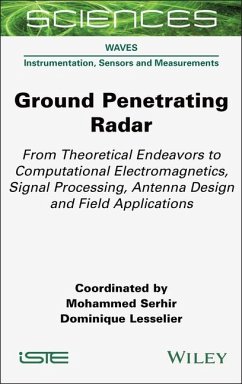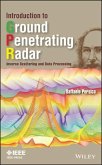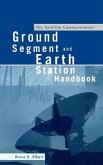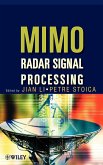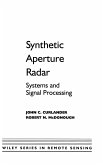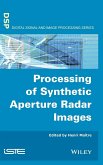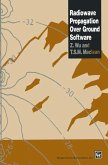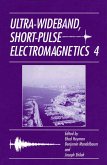Ground Penetrating Radar
From Theoretical Endeavors to Computational Electromagnetics, Signal Processing, Antenna Design and Field Applications
Herausgeber: Serhir, Mohammed; Lesselier, Dominique
Ground Penetrating Radar
From Theoretical Endeavors to Computational Electromagnetics, Signal Processing, Antenna Design and Field Applications
Herausgeber: Serhir, Mohammed; Lesselier, Dominique
- Gebundenes Buch
- Merkliste
- Auf die Merkliste
- Bewerten Bewerten
- Teilen
- Produkt teilen
- Produkterinnerung
- Produkterinnerung
This book offers an overview of modern advances in Ground Penetrating Radar (GPR) for the reader hoping to understand comprehensive electromagnetic culture, combining instrumental development of radar, signal processing, imaging, and calibration/correction of measured data. GPR has a multi-disciplinary character that can bring together a diverse and broad community. Of concern are the design and optimization of innovative radars, by virtue of the antennas and associated electronics, imaging algorithms, methodological diversity, calibration procedures, and the development of tools for the…mehr
Andere Kunden interessierten sich auch für
![Introduction to Ground Penetrating Radar Introduction to Ground Penetrating Radar]() Raffaele PersicoIntroduction to Ground Penetrating Radar145,99 €
Raffaele PersicoIntroduction to Ground Penetrating Radar145,99 €![The Satellite Communication Ground Segment and Earth Station Handbook The Satellite Communication Ground Segment and Earth Station Handbook]() Bruce R. ElbertThe Satellite Communication Ground Segment and Earth Station Handbook173,99 €
Bruce R. ElbertThe Satellite Communication Ground Segment and Earth Station Handbook173,99 €![Mimo Radar Signal Processing Mimo Radar Signal Processing]() Jian LiMimo Radar Signal Processing190,99 €
Jian LiMimo Radar Signal Processing190,99 €![Synthetic Aperture Radar Synthetic Aperture Radar]() John C CurlanderSynthetic Aperture Radar319,99 €
John C CurlanderSynthetic Aperture Radar319,99 €![Processing of Synthetic Aperture Radar (Sar) Images Processing of Synthetic Aperture Radar (Sar) Images]() Processing of Synthetic Aperture Radar (Sar) Images278,99 €
Processing of Synthetic Aperture Radar (Sar) Images278,99 €![Radiowave Propagation Over Ground Software Radiowave Propagation Over Ground Software]() Z. WuRadiowave Propagation Over Ground Software360,99 €
Z. WuRadiowave Propagation Over Ground Software360,99 €![Ultra-Wideband Short-Pulse Electromagnetics 4 Ultra-Wideband Short-Pulse Electromagnetics 4]() Joseph Shiloh / Benjamin Mandelbaum / Ehud Heyman (Hgg.)Ultra-Wideband Short-Pulse Electromagnetics 4239,99 €
Joseph Shiloh / Benjamin Mandelbaum / Ehud Heyman (Hgg.)Ultra-Wideband Short-Pulse Electromagnetics 4239,99 €-
-
-
This book offers an overview of modern advances in Ground Penetrating Radar (GPR) for the reader hoping to understand comprehensive electromagnetic culture, combining instrumental development of radar, signal processing, imaging, and calibration/correction of measured data. GPR has a multi-disciplinary character that can bring together a diverse and broad community. Of concern are the design and optimization of innovative radars, by virtue of the antennas and associated electronics, imaging algorithms, methodological diversity, calibration procedures, and the development of tools for the interpretation of data in mono-static or multi-static configurations within frequency or transient domains. This book provides illustrations in civil engineering for the diagnosis of transport infrastructures and buildings, archeological surveys for the appreciation of cultural heritage, detection of underground pipes and cavities, estimation of soil water content for agriculture, and mapping of root trees developing underground, and in planetology, the analysis of the internal structure of planets and other celestial bodies through electromagnetic waves.
Hinweis: Dieser Artikel kann nur an eine deutsche Lieferadresse ausgeliefert werden.
Hinweis: Dieser Artikel kann nur an eine deutsche Lieferadresse ausgeliefert werden.
Produktdetails
- Produktdetails
- Verlag: Wiley
- Seitenzahl: 304
- Erscheinungstermin: 29. Mai 2024
- Englisch
- Abmessung: 234mm x 156mm x 18mm
- Gewicht: 594g
- ISBN-13: 9781789451573
- ISBN-10: 1789451574
- Artikelnr.: 70172051
- Herstellerkennzeichnung
- Libri GmbH
- Europaallee 1
- 36244 Bad Hersfeld
- gpsr@libri.de
- Verlag: Wiley
- Seitenzahl: 304
- Erscheinungstermin: 29. Mai 2024
- Englisch
- Abmessung: 234mm x 156mm x 18mm
- Gewicht: 594g
- ISBN-13: 9781789451573
- ISBN-10: 1789451574
- Artikelnr.: 70172051
- Herstellerkennzeichnung
- Libri GmbH
- Europaallee 1
- 36244 Bad Hersfeld
- gpsr@libri.de
Mohammed Serhir is Associate Professor at CentraleSupélec, Gif-sur-Yvette, and is part of SONDRA CentraleSupélec ONERA NUS DSO Research Alliance in France. His research interests include GPR, microwave imaging, antenna design, modeling, and measurement in harmonic and time domains. Dominique Lesselier is CNRS Director of Research Emeritus, Laboratoire des Signaux et Systèmes, Gif-sur-Yvette, jointly at Université Paris-Saclay, CNRS and CentraleSupélec in France. His research interests include the development of solutions to inverse problems and imaging methods, encompassing mathematics, numerics, and applications.
Preface xi
Mohammed SERHIR and Dominique LESSELIER
Chapter 1 Electromagnetic Imaging of GPR Data: Theory and Experiments 1
Michele AMBROSANIO, Martina Teresa BEVACQUA, Tommaso ISERNIA and Vito
PASCAZIO
1.1 Inverse scattering problem: mathematical formulation 3
1.2 Inverse scattering problem in case of planarly-layered media 5
1.3 Solution strategies 8
1.4 Qualitative methods 9
1.4.1 Linear Sampling Method 10
1.4.2 Orthogonality sampling method 11
1.4.3 Shape reconstruction via joint sparsity based inverse source and
equivalence principles 12
1.4.4 Applicability and limitations of the three methods 14
1.5 Linearized methods 16
1.5.1 Born approximation 16
1.5.2 Distorted Born approximation 18
1.5.3 A linear approach for quantitative subsurface imaging based on VE 19
1.6 Regularization strategies 21
1.7 An example of multistatic tomographic imaging for GPR prospecting: the
Gergia Tech case 24
1.7.1 Landmines data set 25
1.7.2 Buried pipe 28
1.8 References 29
Chapter 2 Nonlinear and Hybrid Inversion Techniques for Ground Penetrating
Radar Imaging 35
Valentina SCHENONE, Alessandro FEDELI, Matteo PASTORINO¿ and Andrea
RANDAZZO
2.1 GPR imaging as a nonlinear inverse problem 37
2.2 Quantitative inversion 46
2.3 Hybrid techniques 48
2.4 Example of application in a simulated scenario 50
2.5 References 56
Chapter 3 Sensor Deployment in Subsurface GPR Imaging 59
Maria Antonia MAISTO, Angela DELL'AVERSANO, Antonio CUCCARO and Raffaele
SOLIMENE
3.1 Introduction 59
3.2 Linearized scattering model 62
3.3 Inversion 67
3.3.1 Migration 70
3.3.2 A simple pedagogical example 72
3.3.3 The case of unbounded observation domain 74
3.4 Sensor deployment strategy 75
3.4.1 Warping method 78
3.5 References 90
Chapter 4 Ground Penetrating Radar Tomography for Cultural Heritage 97
Ilaria CATAPANO, Giovanni LUDENO, Gianluca GENNARELLI, Giuseppe ESPOSITO,
Lorenzo CROCCO and Francesco SOLDOVIERI
4.1 Introduction 97
4.2 GPRT general concepts 99
4.3 GPRT performance assessment 103
4.4 Effective implementation of GPRT 104
4.5 GPRT surveys in cultural heritage 106
4.5.1 Discovery of a small temple -- archeological park of Paestum and
Velia 106
4.5.2 On the traces of Sir Arthur Evans restorations -- Knossos Palace 110
4.5.3 Surveys of columns -- tombs of the Kings, Paphos, Cyprus 112
4.6 Future perspectives: UAV-based GPRT 115
4.7 References 118
Chapter 5 The Full-Wave Radar Equation for Wave Propagation in Multilayered
Media and Its Applications 123
Sebastien LAMBOT, Kaijun WU, Arthur SLUYTERS and Jean VANDERDONCKT
5.1 Introduction 123
5.2 Far-field radar equation 124
5.3 Determination of the radar--antenna characteristic functions 127
5.4 Planar multilayered media Green's function 129
5.5 Near-field radar equation 132
5.6 Full-wave inversion 136
5.7 Soil moisture mapping application 138
5.7.1 Test sites 139
5.7.2 Radar system 139
5.7.3 Radar calibration 141
5.7.4 Radar images 141
5.7.5 Inversion focused on the surface reflection 143
5.7.6 Conclusions and perspectives 145
5.8 Radar-based interaction 147
5.8.1 Processing pipeline 148
5.8.2 Radar system 149
5.8.3 Results 150
5.8.4 Breathing pattern recognition 154
5.9 Conclusion and perspectives 156
5.10 References 156
Chapter 6 Assessment of Flexible Pavements by GPR: 20 Years of R&D in
France 161
Xavier DEROBERT, Amine IHAMOUTEN, Vincent BALTAZART, David GUILBERT,
Shreedhar Savant TODKAR, Grégory ANDREOLI, Bachir TCHANA-TANKEU,
Jean-Michel SIMONIN and Cyrille FAUCHARD
6.1 Context 161
6.2 GPR systems and acquisition 163
6.3 GPR processing and interpretation 166
6.4 Complementary ND techniques 172
6.4.1 Coring 172
6.4.2 Surface conditions 172
6.4.3 Deflection 173
6.4.4 Other mechanical NDT methods 174
6.4.5 Gammadensimetry 174
6.5 Research and innovations 175
6.5.1 High-frequency stepped-frequency radar approach 176
6.5.2 Super/high time resolution processing 180
6.5.3 Full waveform inversion processing 184
6.5.4 Machine learning processing 188
6.5.5 New orientations 190
6.6 Conclusion 191
6.7 Acknowledgements 192
6.8 References 192
Chapter 7 GPR for Tree Roots Reconstruction under Heterogeneous Soil
Conditions 199
Abderrahmane ABOUDOURIB, Mohammed SERHIR and Dominique LESSELIER
7.1 Introduction 199
7.2 Materials, definitions and methods 202
7.2.1 Root description and modeling 202
7.2.2 Dielectric models for heterogeneous soil 208
7.2.3 Forward electromagnetic simulation 210
7.2.4 Laboratory experiments 211
7.3 Data-processing framework 213
7.3.1 Background removal 214
7.3.2 Soil dielectric permittivity estimation 214
7.3.3 Matched filter technique 216
7.4 Results 218
7.4.1 Results of simulation 218
7.4.2 Experimental results 222
7.5 Discussion 224
7.5.1 Computational times of the processing framework 224
7.5.2 Potentialities of the proposed method 224
7.5.3 Limitations of the proposed method 225
7.5.4 Applicability of the proposed framework to field measurements 225
7.6 Conclusion 226
7.7 References 227
Chapter 8 Sounding Radars and Ground Penetrating Radars Designed for the
Exploration of Our Solar System -- Focus on Planet Mars 233
Valérie CIARLETTI
8.1 Introduction 233
8.2 Overview of the radars designed for planetary missions 235
8.3 Specific constraints on the radar design due to space missions 239
8.3.1 Building the instrument 240
8.3.2 Accommodating the sounding radar on the mission's platform 241
8.3.3 Some specific difficulties on data interpretation 242
8.4 Focus on Mars 246
8.4.1 A very short summary of the exploration of planet Mars 246
8.4.2 Description of the Martian subsurface radars with a few results 248
8.5 Unusual radar designed 258
8.5.1 The tomographic radar CONSERT (Comet Nucleus Sounding Experiment by
Radiowave Transmission) of the ROSETTA mission 259
8.5.2 The LRPR on board the lander of the CHANG'E 5 lunar mission 261
8.6 Future of soundings radars and GPR in solar system exploration 262
8.7 References 264
List of Authors 275
Index 279
Mohammed SERHIR and Dominique LESSELIER
Chapter 1 Electromagnetic Imaging of GPR Data: Theory and Experiments 1
Michele AMBROSANIO, Martina Teresa BEVACQUA, Tommaso ISERNIA and Vito
PASCAZIO
1.1 Inverse scattering problem: mathematical formulation 3
1.2 Inverse scattering problem in case of planarly-layered media 5
1.3 Solution strategies 8
1.4 Qualitative methods 9
1.4.1 Linear Sampling Method 10
1.4.2 Orthogonality sampling method 11
1.4.3 Shape reconstruction via joint sparsity based inverse source and
equivalence principles 12
1.4.4 Applicability and limitations of the three methods 14
1.5 Linearized methods 16
1.5.1 Born approximation 16
1.5.2 Distorted Born approximation 18
1.5.3 A linear approach for quantitative subsurface imaging based on VE 19
1.6 Regularization strategies 21
1.7 An example of multistatic tomographic imaging for GPR prospecting: the
Gergia Tech case 24
1.7.1 Landmines data set 25
1.7.2 Buried pipe 28
1.8 References 29
Chapter 2 Nonlinear and Hybrid Inversion Techniques for Ground Penetrating
Radar Imaging 35
Valentina SCHENONE, Alessandro FEDELI, Matteo PASTORINO¿ and Andrea
RANDAZZO
2.1 GPR imaging as a nonlinear inverse problem 37
2.2 Quantitative inversion 46
2.3 Hybrid techniques 48
2.4 Example of application in a simulated scenario 50
2.5 References 56
Chapter 3 Sensor Deployment in Subsurface GPR Imaging 59
Maria Antonia MAISTO, Angela DELL'AVERSANO, Antonio CUCCARO and Raffaele
SOLIMENE
3.1 Introduction 59
3.2 Linearized scattering model 62
3.3 Inversion 67
3.3.1 Migration 70
3.3.2 A simple pedagogical example 72
3.3.3 The case of unbounded observation domain 74
3.4 Sensor deployment strategy 75
3.4.1 Warping method 78
3.5 References 90
Chapter 4 Ground Penetrating Radar Tomography for Cultural Heritage 97
Ilaria CATAPANO, Giovanni LUDENO, Gianluca GENNARELLI, Giuseppe ESPOSITO,
Lorenzo CROCCO and Francesco SOLDOVIERI
4.1 Introduction 97
4.2 GPRT general concepts 99
4.3 GPRT performance assessment 103
4.4 Effective implementation of GPRT 104
4.5 GPRT surveys in cultural heritage 106
4.5.1 Discovery of a small temple -- archeological park of Paestum and
Velia 106
4.5.2 On the traces of Sir Arthur Evans restorations -- Knossos Palace 110
4.5.3 Surveys of columns -- tombs of the Kings, Paphos, Cyprus 112
4.6 Future perspectives: UAV-based GPRT 115
4.7 References 118
Chapter 5 The Full-Wave Radar Equation for Wave Propagation in Multilayered
Media and Its Applications 123
Sebastien LAMBOT, Kaijun WU, Arthur SLUYTERS and Jean VANDERDONCKT
5.1 Introduction 123
5.2 Far-field radar equation 124
5.3 Determination of the radar--antenna characteristic functions 127
5.4 Planar multilayered media Green's function 129
5.5 Near-field radar equation 132
5.6 Full-wave inversion 136
5.7 Soil moisture mapping application 138
5.7.1 Test sites 139
5.7.2 Radar system 139
5.7.3 Radar calibration 141
5.7.4 Radar images 141
5.7.5 Inversion focused on the surface reflection 143
5.7.6 Conclusions and perspectives 145
5.8 Radar-based interaction 147
5.8.1 Processing pipeline 148
5.8.2 Radar system 149
5.8.3 Results 150
5.8.4 Breathing pattern recognition 154
5.9 Conclusion and perspectives 156
5.10 References 156
Chapter 6 Assessment of Flexible Pavements by GPR: 20 Years of R&D in
France 161
Xavier DEROBERT, Amine IHAMOUTEN, Vincent BALTAZART, David GUILBERT,
Shreedhar Savant TODKAR, Grégory ANDREOLI, Bachir TCHANA-TANKEU,
Jean-Michel SIMONIN and Cyrille FAUCHARD
6.1 Context 161
6.2 GPR systems and acquisition 163
6.3 GPR processing and interpretation 166
6.4 Complementary ND techniques 172
6.4.1 Coring 172
6.4.2 Surface conditions 172
6.4.3 Deflection 173
6.4.4 Other mechanical NDT methods 174
6.4.5 Gammadensimetry 174
6.5 Research and innovations 175
6.5.1 High-frequency stepped-frequency radar approach 176
6.5.2 Super/high time resolution processing 180
6.5.3 Full waveform inversion processing 184
6.5.4 Machine learning processing 188
6.5.5 New orientations 190
6.6 Conclusion 191
6.7 Acknowledgements 192
6.8 References 192
Chapter 7 GPR for Tree Roots Reconstruction under Heterogeneous Soil
Conditions 199
Abderrahmane ABOUDOURIB, Mohammed SERHIR and Dominique LESSELIER
7.1 Introduction 199
7.2 Materials, definitions and methods 202
7.2.1 Root description and modeling 202
7.2.2 Dielectric models for heterogeneous soil 208
7.2.3 Forward electromagnetic simulation 210
7.2.4 Laboratory experiments 211
7.3 Data-processing framework 213
7.3.1 Background removal 214
7.3.2 Soil dielectric permittivity estimation 214
7.3.3 Matched filter technique 216
7.4 Results 218
7.4.1 Results of simulation 218
7.4.2 Experimental results 222
7.5 Discussion 224
7.5.1 Computational times of the processing framework 224
7.5.2 Potentialities of the proposed method 224
7.5.3 Limitations of the proposed method 225
7.5.4 Applicability of the proposed framework to field measurements 225
7.6 Conclusion 226
7.7 References 227
Chapter 8 Sounding Radars and Ground Penetrating Radars Designed for the
Exploration of Our Solar System -- Focus on Planet Mars 233
Valérie CIARLETTI
8.1 Introduction 233
8.2 Overview of the radars designed for planetary missions 235
8.3 Specific constraints on the radar design due to space missions 239
8.3.1 Building the instrument 240
8.3.2 Accommodating the sounding radar on the mission's platform 241
8.3.3 Some specific difficulties on data interpretation 242
8.4 Focus on Mars 246
8.4.1 A very short summary of the exploration of planet Mars 246
8.4.2 Description of the Martian subsurface radars with a few results 248
8.5 Unusual radar designed 258
8.5.1 The tomographic radar CONSERT (Comet Nucleus Sounding Experiment by
Radiowave Transmission) of the ROSETTA mission 259
8.5.2 The LRPR on board the lander of the CHANG'E 5 lunar mission 261
8.6 Future of soundings radars and GPR in solar system exploration 262
8.7 References 264
List of Authors 275
Index 279
Preface xi
Mohammed SERHIR and Dominique LESSELIER
Chapter 1 Electromagnetic Imaging of GPR Data: Theory and Experiments 1
Michele AMBROSANIO, Martina Teresa BEVACQUA, Tommaso ISERNIA and Vito
PASCAZIO
1.1 Inverse scattering problem: mathematical formulation 3
1.2 Inverse scattering problem in case of planarly-layered media 5
1.3 Solution strategies 8
1.4 Qualitative methods 9
1.4.1 Linear Sampling Method 10
1.4.2 Orthogonality sampling method 11
1.4.3 Shape reconstruction via joint sparsity based inverse source and
equivalence principles 12
1.4.4 Applicability and limitations of the three methods 14
1.5 Linearized methods 16
1.5.1 Born approximation 16
1.5.2 Distorted Born approximation 18
1.5.3 A linear approach for quantitative subsurface imaging based on VE 19
1.6 Regularization strategies 21
1.7 An example of multistatic tomographic imaging for GPR prospecting: the
Gergia Tech case 24
1.7.1 Landmines data set 25
1.7.2 Buried pipe 28
1.8 References 29
Chapter 2 Nonlinear and Hybrid Inversion Techniques for Ground Penetrating
Radar Imaging 35
Valentina SCHENONE, Alessandro FEDELI, Matteo PASTORINO¿ and Andrea
RANDAZZO
2.1 GPR imaging as a nonlinear inverse problem 37
2.2 Quantitative inversion 46
2.3 Hybrid techniques 48
2.4 Example of application in a simulated scenario 50
2.5 References 56
Chapter 3 Sensor Deployment in Subsurface GPR Imaging 59
Maria Antonia MAISTO, Angela DELL'AVERSANO, Antonio CUCCARO and Raffaele
SOLIMENE
3.1 Introduction 59
3.2 Linearized scattering model 62
3.3 Inversion 67
3.3.1 Migration 70
3.3.2 A simple pedagogical example 72
3.3.3 The case of unbounded observation domain 74
3.4 Sensor deployment strategy 75
3.4.1 Warping method 78
3.5 References 90
Chapter 4 Ground Penetrating Radar Tomography for Cultural Heritage 97
Ilaria CATAPANO, Giovanni LUDENO, Gianluca GENNARELLI, Giuseppe ESPOSITO,
Lorenzo CROCCO and Francesco SOLDOVIERI
4.1 Introduction 97
4.2 GPRT general concepts 99
4.3 GPRT performance assessment 103
4.4 Effective implementation of GPRT 104
4.5 GPRT surveys in cultural heritage 106
4.5.1 Discovery of a small temple -- archeological park of Paestum and
Velia 106
4.5.2 On the traces of Sir Arthur Evans restorations -- Knossos Palace 110
4.5.3 Surveys of columns -- tombs of the Kings, Paphos, Cyprus 112
4.6 Future perspectives: UAV-based GPRT 115
4.7 References 118
Chapter 5 The Full-Wave Radar Equation for Wave Propagation in Multilayered
Media and Its Applications 123
Sebastien LAMBOT, Kaijun WU, Arthur SLUYTERS and Jean VANDERDONCKT
5.1 Introduction 123
5.2 Far-field radar equation 124
5.3 Determination of the radar--antenna characteristic functions 127
5.4 Planar multilayered media Green's function 129
5.5 Near-field radar equation 132
5.6 Full-wave inversion 136
5.7 Soil moisture mapping application 138
5.7.1 Test sites 139
5.7.2 Radar system 139
5.7.3 Radar calibration 141
5.7.4 Radar images 141
5.7.5 Inversion focused on the surface reflection 143
5.7.6 Conclusions and perspectives 145
5.8 Radar-based interaction 147
5.8.1 Processing pipeline 148
5.8.2 Radar system 149
5.8.3 Results 150
5.8.4 Breathing pattern recognition 154
5.9 Conclusion and perspectives 156
5.10 References 156
Chapter 6 Assessment of Flexible Pavements by GPR: 20 Years of R&D in
France 161
Xavier DEROBERT, Amine IHAMOUTEN, Vincent BALTAZART, David GUILBERT,
Shreedhar Savant TODKAR, Grégory ANDREOLI, Bachir TCHANA-TANKEU,
Jean-Michel SIMONIN and Cyrille FAUCHARD
6.1 Context 161
6.2 GPR systems and acquisition 163
6.3 GPR processing and interpretation 166
6.4 Complementary ND techniques 172
6.4.1 Coring 172
6.4.2 Surface conditions 172
6.4.3 Deflection 173
6.4.4 Other mechanical NDT methods 174
6.4.5 Gammadensimetry 174
6.5 Research and innovations 175
6.5.1 High-frequency stepped-frequency radar approach 176
6.5.2 Super/high time resolution processing 180
6.5.3 Full waveform inversion processing 184
6.5.4 Machine learning processing 188
6.5.5 New orientations 190
6.6 Conclusion 191
6.7 Acknowledgements 192
6.8 References 192
Chapter 7 GPR for Tree Roots Reconstruction under Heterogeneous Soil
Conditions 199
Abderrahmane ABOUDOURIB, Mohammed SERHIR and Dominique LESSELIER
7.1 Introduction 199
7.2 Materials, definitions and methods 202
7.2.1 Root description and modeling 202
7.2.2 Dielectric models for heterogeneous soil 208
7.2.3 Forward electromagnetic simulation 210
7.2.4 Laboratory experiments 211
7.3 Data-processing framework 213
7.3.1 Background removal 214
7.3.2 Soil dielectric permittivity estimation 214
7.3.3 Matched filter technique 216
7.4 Results 218
7.4.1 Results of simulation 218
7.4.2 Experimental results 222
7.5 Discussion 224
7.5.1 Computational times of the processing framework 224
7.5.2 Potentialities of the proposed method 224
7.5.3 Limitations of the proposed method 225
7.5.4 Applicability of the proposed framework to field measurements 225
7.6 Conclusion 226
7.7 References 227
Chapter 8 Sounding Radars and Ground Penetrating Radars Designed for the
Exploration of Our Solar System -- Focus on Planet Mars 233
Valérie CIARLETTI
8.1 Introduction 233
8.2 Overview of the radars designed for planetary missions 235
8.3 Specific constraints on the radar design due to space missions 239
8.3.1 Building the instrument 240
8.3.2 Accommodating the sounding radar on the mission's platform 241
8.3.3 Some specific difficulties on data interpretation 242
8.4 Focus on Mars 246
8.4.1 A very short summary of the exploration of planet Mars 246
8.4.2 Description of the Martian subsurface radars with a few results 248
8.5 Unusual radar designed 258
8.5.1 The tomographic radar CONSERT (Comet Nucleus Sounding Experiment by
Radiowave Transmission) of the ROSETTA mission 259
8.5.2 The LRPR on board the lander of the CHANG'E 5 lunar mission 261
8.6 Future of soundings radars and GPR in solar system exploration 262
8.7 References 264
List of Authors 275
Index 279
Mohammed SERHIR and Dominique LESSELIER
Chapter 1 Electromagnetic Imaging of GPR Data: Theory and Experiments 1
Michele AMBROSANIO, Martina Teresa BEVACQUA, Tommaso ISERNIA and Vito
PASCAZIO
1.1 Inverse scattering problem: mathematical formulation 3
1.2 Inverse scattering problem in case of planarly-layered media 5
1.3 Solution strategies 8
1.4 Qualitative methods 9
1.4.1 Linear Sampling Method 10
1.4.2 Orthogonality sampling method 11
1.4.3 Shape reconstruction via joint sparsity based inverse source and
equivalence principles 12
1.4.4 Applicability and limitations of the three methods 14
1.5 Linearized methods 16
1.5.1 Born approximation 16
1.5.2 Distorted Born approximation 18
1.5.3 A linear approach for quantitative subsurface imaging based on VE 19
1.6 Regularization strategies 21
1.7 An example of multistatic tomographic imaging for GPR prospecting: the
Gergia Tech case 24
1.7.1 Landmines data set 25
1.7.2 Buried pipe 28
1.8 References 29
Chapter 2 Nonlinear and Hybrid Inversion Techniques for Ground Penetrating
Radar Imaging 35
Valentina SCHENONE, Alessandro FEDELI, Matteo PASTORINO¿ and Andrea
RANDAZZO
2.1 GPR imaging as a nonlinear inverse problem 37
2.2 Quantitative inversion 46
2.3 Hybrid techniques 48
2.4 Example of application in a simulated scenario 50
2.5 References 56
Chapter 3 Sensor Deployment in Subsurface GPR Imaging 59
Maria Antonia MAISTO, Angela DELL'AVERSANO, Antonio CUCCARO and Raffaele
SOLIMENE
3.1 Introduction 59
3.2 Linearized scattering model 62
3.3 Inversion 67
3.3.1 Migration 70
3.3.2 A simple pedagogical example 72
3.3.3 The case of unbounded observation domain 74
3.4 Sensor deployment strategy 75
3.4.1 Warping method 78
3.5 References 90
Chapter 4 Ground Penetrating Radar Tomography for Cultural Heritage 97
Ilaria CATAPANO, Giovanni LUDENO, Gianluca GENNARELLI, Giuseppe ESPOSITO,
Lorenzo CROCCO and Francesco SOLDOVIERI
4.1 Introduction 97
4.2 GPRT general concepts 99
4.3 GPRT performance assessment 103
4.4 Effective implementation of GPRT 104
4.5 GPRT surveys in cultural heritage 106
4.5.1 Discovery of a small temple -- archeological park of Paestum and
Velia 106
4.5.2 On the traces of Sir Arthur Evans restorations -- Knossos Palace 110
4.5.3 Surveys of columns -- tombs of the Kings, Paphos, Cyprus 112
4.6 Future perspectives: UAV-based GPRT 115
4.7 References 118
Chapter 5 The Full-Wave Radar Equation for Wave Propagation in Multilayered
Media and Its Applications 123
Sebastien LAMBOT, Kaijun WU, Arthur SLUYTERS and Jean VANDERDONCKT
5.1 Introduction 123
5.2 Far-field radar equation 124
5.3 Determination of the radar--antenna characteristic functions 127
5.4 Planar multilayered media Green's function 129
5.5 Near-field radar equation 132
5.6 Full-wave inversion 136
5.7 Soil moisture mapping application 138
5.7.1 Test sites 139
5.7.2 Radar system 139
5.7.3 Radar calibration 141
5.7.4 Radar images 141
5.7.5 Inversion focused on the surface reflection 143
5.7.6 Conclusions and perspectives 145
5.8 Radar-based interaction 147
5.8.1 Processing pipeline 148
5.8.2 Radar system 149
5.8.3 Results 150
5.8.4 Breathing pattern recognition 154
5.9 Conclusion and perspectives 156
5.10 References 156
Chapter 6 Assessment of Flexible Pavements by GPR: 20 Years of R&D in
France 161
Xavier DEROBERT, Amine IHAMOUTEN, Vincent BALTAZART, David GUILBERT,
Shreedhar Savant TODKAR, Grégory ANDREOLI, Bachir TCHANA-TANKEU,
Jean-Michel SIMONIN and Cyrille FAUCHARD
6.1 Context 161
6.2 GPR systems and acquisition 163
6.3 GPR processing and interpretation 166
6.4 Complementary ND techniques 172
6.4.1 Coring 172
6.4.2 Surface conditions 172
6.4.3 Deflection 173
6.4.4 Other mechanical NDT methods 174
6.4.5 Gammadensimetry 174
6.5 Research and innovations 175
6.5.1 High-frequency stepped-frequency radar approach 176
6.5.2 Super/high time resolution processing 180
6.5.3 Full waveform inversion processing 184
6.5.4 Machine learning processing 188
6.5.5 New orientations 190
6.6 Conclusion 191
6.7 Acknowledgements 192
6.8 References 192
Chapter 7 GPR for Tree Roots Reconstruction under Heterogeneous Soil
Conditions 199
Abderrahmane ABOUDOURIB, Mohammed SERHIR and Dominique LESSELIER
7.1 Introduction 199
7.2 Materials, definitions and methods 202
7.2.1 Root description and modeling 202
7.2.2 Dielectric models for heterogeneous soil 208
7.2.3 Forward electromagnetic simulation 210
7.2.4 Laboratory experiments 211
7.3 Data-processing framework 213
7.3.1 Background removal 214
7.3.2 Soil dielectric permittivity estimation 214
7.3.3 Matched filter technique 216
7.4 Results 218
7.4.1 Results of simulation 218
7.4.2 Experimental results 222
7.5 Discussion 224
7.5.1 Computational times of the processing framework 224
7.5.2 Potentialities of the proposed method 224
7.5.3 Limitations of the proposed method 225
7.5.4 Applicability of the proposed framework to field measurements 225
7.6 Conclusion 226
7.7 References 227
Chapter 8 Sounding Radars and Ground Penetrating Radars Designed for the
Exploration of Our Solar System -- Focus on Planet Mars 233
Valérie CIARLETTI
8.1 Introduction 233
8.2 Overview of the radars designed for planetary missions 235
8.3 Specific constraints on the radar design due to space missions 239
8.3.1 Building the instrument 240
8.3.2 Accommodating the sounding radar on the mission's platform 241
8.3.3 Some specific difficulties on data interpretation 242
8.4 Focus on Mars 246
8.4.1 A very short summary of the exploration of planet Mars 246
8.4.2 Description of the Martian subsurface radars with a few results 248
8.5 Unusual radar designed 258
8.5.1 The tomographic radar CONSERT (Comet Nucleus Sounding Experiment by
Radiowave Transmission) of the ROSETTA mission 259
8.5.2 The LRPR on board the lander of the CHANG'E 5 lunar mission 261
8.6 Future of soundings radars and GPR in solar system exploration 262
8.7 References 264
List of Authors 275
Index 279

